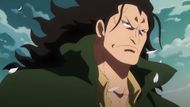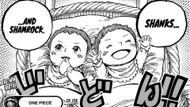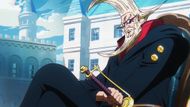For decades, Monkey D. Dragon has been one of One Piece’s most mysterious figures. As the leader of the Revolutionary Army and father of Monkey D. Luffy, his shadow looms large over the story, yet Eiichiro Oda has revealed precious little about his origins.
One Piece chapter 1160 is no mere flashback; it’s a monumental turning point in the saga. For the first time, we witness the birth of Dragon’s resolve, the shocking cruelty of the God Valley Incident, and the tragedy that reshaped legends like Kuma and Shanks.
For years, Dragon’s reputation has been built on whispers: the “World’s Worst Criminal,” the unflinching enemy of the Celestial Dragons, and the man working tirelessly to dismantle centuries of oppression. Yet until now, we never saw the moment where he stepped away from the path of a dutiful Marine into the life of a revolutionary.

Chapter 1160 gives us that moment. During the infamous God Valley tournament, an event where Celestial Dragons hunt humans for sport, Dragon defies his orders and shoots a Celestial Dragon to protect Bartholomew Kuma.
This single gunshot is the seed of the Revolutionary Army. By firing it, Dragon symbolically rejects everything the Celestial Dragons represent. No longer can he remain complicit as a Marine enforcing their will.
One chapter earlier, in One Piece 1159, we saw Dragon’s debut as a young Marine. Even then, he stood apart from his comrades. He refused to kill his targets, relying on tranquilizers rather than bullets. He openly questioned the morality of the God Valley mission, only to be silenced by his superiors.
Protecting Shanks and Shamrock

The climax of One Piece Chapter 1160 elevates Dragon from rebel to savior. As the Celestial Dragons’ “hunting game” spirals into carnage, Dragon risks his life to save two children: Shanks and his twin sister, Shamrock.
This moment carries staggering implications for the future of One Piece. By saving Shanks, Dragon directly shapes the path of history. Shanks would later be taken in by Gol D. Roger, grow into one of the Four Emperors, and eventually become a pillar of balance in the New World. Without Dragon’s intervention, Shanks’ story could have ended in tragedy in God Valley.
For Shamrock, a new and mysterious figure, his survival hints at untold stories yet to be revealed. That Dragon was willing to shield them both underscores his empathy, even in the face of unimaginable danger.
The cruelty of Figarland Garling

If Dragon is the symbol of resistance, then Figarland Garling embodies the rotting heart of Celestial Dragon cruelty. Chapter 1159 painted him as one of the vilest figures in the series. We learn that Garling fathered Shanks and Shamrock, yet betrayed their mother in cold blood.
When she begged him to stay, he responded not with compassion but by stabbing her, declaring that his “true wife” would be chosen during the God Valley tournament. It is a chilling revelation: Garling not only participated in the atrocities of God Valley but did so while discarding his own children’s mother.
This revelation reframes Garling as more than a tyrant; he is personal evil, the antithesis of Dragon’s compassion. Their ideological clash adds yet another layer of weight to the events of God Valley.
Dragon does not fight for glory, nor does he revel in violence. He fights because he cannot stand by while others suffer. Chapter 1160 shows the origin of this empathy and frames it as a rebellion not just against the Celestial Dragons, but against fate itself.
Why One Piece Chapter 1160 matters

Oda has delivered many legendary flashbacks in One Piece: Robin’s tragedy at Ohara, Law’s survival in Flevance, and Oden’s final stand in Wano. But Chapter 1160 belongs in that pantheon.
It is the flashback, the one fans have waited decades to see. It ties together the mysteries of God Valley, the origins of Dragon’s rebellion, and the survival of Shanks. It shows us the human tragedies that birthed legends and reminds us that behind every great pirate or revolutionary lies a story of pain, loss, and defiance.
Most importantly, it transforms Dragon from a figure of hype into a figure of history. No longer is he just Luffy’s enigmatic father or the “World’s Worst Criminal.” Now we understand why he fights and why his fight matters.
By standing against Garling and the World Nobles, he revealed the moral courage that would inspire generations. For years, Dragon hype has been simmering in the background of One Piece. With Chapter 1160, that hype finally bears fruit.
